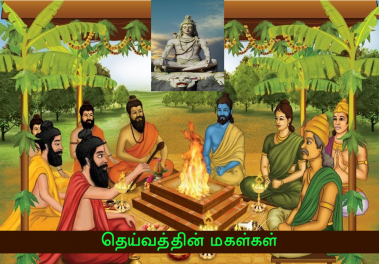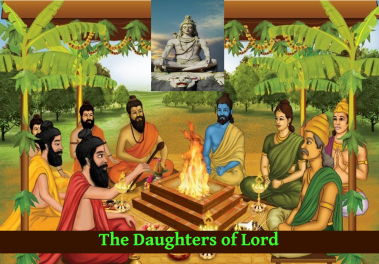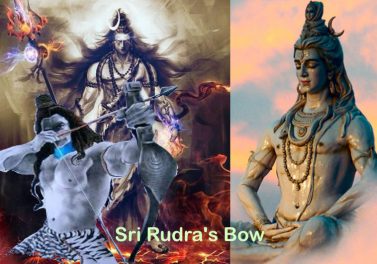ATMA RAMA
Conversation With Aiya (34)
“Yes Aiya, it was a lovely long day, filled with enchanting bhajan and puja etc., all ending with delightful food as prashād. In the UK, throughout the week, there were Śrī Rāmanavami celebrations and I must say, those drew a lot of parallels to what we witness in India. Great celebrations!”
I was giving a brief update to Aiya, whom I was seeing after a few months.
“Great to know! Celebration is the right-word as all our puja and religious rites underline only the importance of keeping ourselves in the celebration-mood at all times”
“Yes Aiya! Remembering the birth-day of Śrī Rāma and other such great avatar is very important, is it not!”
With a smile Aiya asked: “Perhaps! Why do you think so?”
I said: “Śrī Rāmanavami is the birth celebration of Lord Rāma and it is important that the entire humanity knows about Rāma’s life; hearing the recital of Rāmāyana that describes the life of Rāma is very important for our learning and development”
“Indeed!”, said Aiya, “but also be reminded!”.
He continued.
“Sage Vālmiki named the monumental history of Śrī Rāma’s life as ‘the Journey of Rāma’. The word ‘ayana’ in Sanskrit means the journey”
I interrupted.
‘Like the words ‘uttarāyana’ ‘dakshināyana’ etc.?”
“Yes, the journey of Rāma is about the path of righteousness in this world, which must be adhered to, in all adversities and opportunities, in all sorrow and joy, in all roles and deeds”.
“Yes Aiya, following the divine path! Is not Śrī Rāma the very incarnation of Lord Vishnu!”
Aiya was quick to respond.
“That’s how we adore Śrī Rāma. But that assertion, however virtuous may be, is not necessary for learning from Rāmāyana, especially if we need to understand Rāma.”
After a brief pause Aiya continued.
“Sage Vālmiki does not project Rāma as the Lord-Incarnate, right from the beginning. Of course, at the end, he respectfully concludes that Rāma is none other than Iśvara, Who manifested as an embodied being in this world, to show righteous living to all.”
As I have read some versions of Rāmāyana, I asked.
“Aiya, In the Kamba-Rāmāyana, the composer venerable Kambar reveres Śrī Rāma as the very incarnation of Lord, right from the start! Is that not so!”
“Yes, that is beautiful! You may also know venerable Tulsidas also start with the same reverence in his version of Rāmāyana, the Rāma Charita Manas. It is interesting to learn how he wonders about Rāma, and at the end reverently worships Śrī Rāma as ‘mariyātha purushottam’, the most honourable human-being.”
“Aiya, how do these things matter! Ultimately, Śrī Rāma is our God.”
“Of course, there is no question on that! Also, no scarcity of gods in our Sanātana Dharma; there are many in names and forms, only to ultimately teach that there is ONLY GOD in all manifestations.”
Aiya continued:
“My limited point here is that we may lose sight of the learning prospects when the blind-worship overshadows the quest for right knowledge. Knowing the truth is through contemplation and that process in the formative stages is called ‘Upāsana’ or meditative contemplation. The religious rites and actions are ‘Karma’. Bur only when Karma is combined with corresponding Upāsana, which is referred in the scriptures as ‘Karma-Upāsana-Samuchchayam’, one attains the maximum benefit.”
“Aiya, are not all puja and rituals enough? What do you mean by the corresponding Upāsana? How and when to do the Upāsana?”
I was curious as I didn’t want to miss.
Aiya said:
“Take it simply: while Karma is done outwards, applying your body, words, thoughts etc. with or without the use of external objects, Upāsana is only done in the mind. You can say that it is ‘mānasa-karma’. When we are celebrating Śrī Rāmanavami, the Upāsana corresponds to the meditative contemplation of Śrī Rāma, His glory, His Truth etc.”
“When should such Upāsana be done?”
“Whenever! Ideally while doing the Karma itself, but it may not be possible for all at all the times. That is why Karmas are to be done as dedicated as possible to the prescribed rules, then the Upāsana follows. Upāsana could be when One is contemplating within oneself about the meaning of the mantras, divine names etc. Or when One is listening to the discourses by noble people on the subject of worship. The idea is to inquire and achieve an impact in the heart, for a positive transformation!”
“Aiya, can I deem this discussion therefore an Upāsana?”
“You could, provided there is shradda in both of us – the teacher and the seeker!” – Aiya laughed loudly.
“Aiya, I said that the festivals such a Śrī Rāmanavami are to remind us about the need to enjoy life! Happiness is all our goal.”
“Yes, happiness it is! But if you think happiness is the celebrative mood and the joy of sharing good ambience, divine music and sumptuous food in the festivities, then you are only partially right.”
“Why?”
“It is trivial as you could vouch for yourself; is not at the end of the festivities, you are back to your daily chores of life and the happiness of Śrī Rāmanavami festival quickly becomes a good memory!”
“That is natural Aiya. When the functions are over, we have to be with the ordeals of our lives; those take the toll. That is why I think, that our Sanātana Dharma fills the whole year with periodic distribution of festivities and religious acts for us to recharge.”
“Well, in that case, you could as well replace these religious festivities with social parties, which also give happiness during the partying-time.”
I was waiting to receive more.
“Happiness is not about the experience of joyous occasions. The very word ‘occasion’ infers that those occur; so are temporal. Happiness that is advocated in Sanātana Dharma is Ananda, which is everlasting”
“…an enduring experience of joy?” – I said.
Aiya replied:
“I am not playing with words. Understand the inner meaning, the ‘tātparya’. Experience is what the mind brings to realization. It could be pain or pleasure or their mix. It comes and goes and thus, every experience is a thought. Patanjali calls it ‘citta-vritti’, a ripple of thought in the otherwise tranquil mind.”
“That may be Aiya! After all, don’t we all seek that those ripple of thoughts, citta-vritti, be joyous and pleasant?”.
“Of course! But making an experience to be a joyous-one or a sad-one is the inherent bias of the mind. An experience which is usually joyful to you, at sometimes, may put you in bitter experience. That’s because of the onslaught of other overriding ‘citta-vritti’ that come and go. So, the result of all your objective experiences do not leave you perpetually happy or forever sad, except shuttling you between those polarities.”
“Aiya, then what is Ananda?”
“It is not the oscillation between the Joy and Grief or Pleasure and Pain, but to be at the centre, undisturbed and untouched by the vacillating mind. Being in that state of balance means that there is no impact of vritti; there only the natural state of your being persists. That natural state of you is Ananda, bliss, eternal peace, the unallied joy.”
“Aiya, how is Śrī Rāmanavami celebration leads to such Ananda?”
“Not only Śrī Rāmanavami as every festival or Satsangh that brings out the import of Sanātana Dharma, steer us only towards such Ananda, may be slowly for some, but surely for all. The only prerequisite is that we must be prepared for such a pursuit to perfection.”
“How Aiya?”
“Simply by understanding the import of Rāmāyana. As I told you before, Rāmāyana is not a biography, although one can treat it as such! What is the point of knowing about Rāma and his life-events, that are highly dramatic with many interesting twists, like He losing His kingdom, losing His wife, needing a long battle in order to kill the abductor and to win back His wife etc. You may say – such things don’t happen these days or that you don’t have a life condition similar to Rāma, and therefore not relevant to your life. If you say so, then why read Rāmāyana, celebrate Rāmanavami etc?”
“Aiya, it is because Śrī Rāma is our God. Singing the glory of God is a virtuous act! Performing puja to our God brings prosperity to us. How can we question that?”
“I am not questioning that! All prayers and rites when performed correctly and with the clear motivation to obtain results, surely bestow the same! As God can be worshipped in all forms and names, all prayers that are done with utmost sincerity must bear good results, so, no question there! I only draw your attention to the finer points of knowing our legends and the related festivities. There is deeper meaning. The grasping of the import brings transformation in you. It will steer your desires in the direction of Ananda. It will alter the way your actions and attitudes are expressed in your life. It prepares you to take up the same path of Śrī Rāma, not for the twists and turns from the chores of life, but for the pure witnessing nature of Śrī Rāma, the everlasting bliss of Ātma Rāma!”
I was listening.
“It is not easy for all seeing the divinity in all; seeing so is the sign of ripen knowledge! No question about that. But for the most of us, God is simply reduced to a reverential object, which is far-away and always beyond our reach. That’s why, anything godly, we keep outside our rational thinking. Don’t you see that many keep the text of Bhagavad-Gita in tightly sealed hard-copy as a holy book in the prayer room, only to worship with Arti and keeping it reverentially untouched! Won’t you agree, even saintly teachers who we do not take so seriously while they live amongst us, but upon their disembodiment, become our gods and we are so happy to keep their idols or pictures in our prayer rooms and bombard them with our daily prayers for bestowing grace! God, for the many of us, is just a convenience, an excuse to unladen our anxieties or worries; God for us is just the unknowable power to grant us what we seek, when we seek! That’s why God does not enter into our lives, unless there is grief or some hardship comes to strike!”
Feeling the guilt in my heart, I said.
“Aiya, I accept! Seeing Rāma as a human-being evokes a desire to emulate His conduct and the courage to question the events in His life and learn! God taking birth as Human-being and doing great things in this world is adorable but what is there for us to wonder; is not GOD capable of doing anything that is humanly impossible! But seeing Rāma as a Man of wonderful virtues, valour and just, and by being so attaining divine-hood is lot more inspiring to me. I concede!”
Aiya smiled.
“That is good; I am only asking you to use all perspectives to learn from Rāmāyana to uphold divine values and upgrade your prospect.”
“Thank you Aiya. I have another doubt! What about those who do not have real faith in the history of Rāma! What about those who reads it as a fascinating tale only! How does Rāmāyana impact in effecting their transformation!”
“Well, firstly, let this be known: faith is neither a need nor a barrier to progress! I mean, whether one believe or not believes, Truth always exists. Therefore, faith can be easily replaced by far stronger trait: the reasoning”.
“You mean being logical?”
“Reasoning which is far more than logic! Is logic not operating on what one can perceive! Logic deals with the objects and facts. Are not facts merely what the mind factorises from what it perceives!”
“I don’t understand Aiya!”
“Can you logically negate my dream experience?”
“No Aiya! Dream is not logical…. I mean, it is not something I can call it as a fact as it is not in my perception.”
“Exactly! So, Logic has a place but there are also places of experiences that form your life, where logic has no place! Do you follow!”
“Yes, Logic is only an instrument useful in certain objective domain! I get it.”
“Reasoning is to be taken as a fine sense of awareness that intuitively sees what logic may not see, as plausible. Reasoning may come out of past experiences, intuitive awareness, deep memories of experiences…. all these are in our subconscious minds.”
After deliberate pause, Aiya continued.
“Let us not go deeper right now. What I am saying is, to look at Rāmāyana in the spirit of Vedanta, where reasoning is the foremost instrument for contemplation, only subservient to ‘shraddha’, the unassailable commitment to learn.”
“Tell me Aiya, please!”
“Rāma is the Ātma the effulgent consciousness bliss, that pervades all, and indwells in all. Rāma manifests luminously when the clouding-senses, which are in the form of ten organs of actions and perceptions are kept under control. That was the state signified by the King Daśarath, who was famous for his ability to control ten chariots at a time!”
“Aiya, controlling all our senses is a mammoth task!”
“Yes! That is possible only when there is peace! When the senses are in control, there is peace too. Peace means no war! That is what Ayodhya represents: a+yudda, a place of no war! That is why in Ayodhya, to King Daśarath, Rāma, the effulgent consciousness luminously manifests”.
I was all ears as Aiya continued.
“You know about Janaka. The term ‘janaka’ means the parent or the creator! When Janaka ploughed the earth, he dug out Sītā, the Māya, the weaver of all creations, the Prakrti. She is the power of all-knowing-Consciousness, Iśvara. When Sītā, who represents the ‘manas’ weds Rāma, then there comes the ‘Jeeva’, the deluded existence, the ego, forgetting the true nature of the Self as Atma. Yet, it is a blissful union; where there is the union of Rāma and Sītā, there is happiness!”
“But, Aiya, didn’t Sītā face hardships?”
“Yes, so did Rāma too. When Māya is wedded, ordeals occur at all times and the result is hardships.”
“Aiya, are you referring to when they were ordained to spend the fourteen years of life in the forest?”
“Yes. That’s when Rāma and Sītā were forced to leave the peace of Ayodhya and had to endure the scorching heat and hardships of the forest. With the support of Lakshmana, the embodiment of bhakti and vairāghyam, devotion and dispassion, even against those ordeals, both Rāma and Sītā were blissfully happy! Trouble starts only when Sītā, the mind, turned away from Rāma, the Atma!”
“Aiya, I recall reading how poignantly Sītā made the plea that she would walk in the front of Rāma in the forest so that she could bear the hard thorns on the way to protect Rāma.”
“Indeed, but now see the irony! That was when Sītā’s attention had also away from Rāma. She was looking all out there in the world, allowing the objective desires surfacing in the front. Didn’t the golden deer that caught her eyes make her to drive Rāma and Lakshmana far away from her?”
“Yes Aiya!”
“When Sītā’s attention moved away from Rāma, there was grief. Where the mind is focused eternally on the indwelling effulgence of consciousness there is peace, otherwise grief! That’s what you must understand!”
“That’s why Rāvana kidnapped her?” – I asked.
“Yes, when the mind wanders away from the inner tranquillity, and also withdraws the protection of Bhakti and Shradda that helped in focusing towards the Ātma, the mind falls and becomes entrapped in all sorts of external desires. That is when the ten types of afflictions arise to take control. This is what the ‘Dashakanta’ Rāvana embodied.”
“Yes Aiya, it is indeed an irony. When there is control on all ten indriyā, there is peace. When there is no control, then three is havoc by ten types of afflictions, there is war.”
“Yes, the deluded ego, in the form of grieving Sītā, is now entrapped by the evil qualities of the mind. It invites temptations.”
“Like the demon Rāvana who was tempting Sītā with lots of treasures and titles!” – I pondered.
“Yes! But Sītā, who had already had the joy of facing the Atma Rāma, could not fail! She discarded all the temptations. Her resolve to unite with Rāma grew more than ever, in the presence of temptations and grief.”
“Aiya, is not sorrow triggers contemplation towards truth?”
“Yes! Only when shokam hits hard, the darkness of moham or the delusion is recognized and we start to look for redemption, like Arjuna who converted his delusion (vishāda) into path for redemption (Yoga) as we see in Bhagavad-gita!”
“Yes Aiya, why are we thinking of God only when we are in distress!” – I lamented with guilt.
“Do not feel guilty. We don’t seek God when we are happy…. Generally! That is ok. God knows that our happiness is temporal and when grief strikes, we will eventually seek God.”
“Does it mean, God causes grief in order to make us go to Him!”
“No! God is not somewhere that you must go and find! God is absolute happiness. So even in any shade of happiness, you are with God only. So, when you are happy and if you are not seeking God, that’s ok, because you are only with God Whose form is happiness.”
“Aiya! That is good to know! But when I am unhappy, God is not with me and therefore I must go and see Him because He is the Happiness. Correct?”
“Not so!”
“Why Ayya? You only said God is Happiness and so God cannot be Grief!”
“Let us not define God, as we cannot! Let us also don’t delude that God is somehow away from us when we are not happy. God is always with us, within us. When you are unhappy also, God is with you only.”
“That means, you are saying God is both Happiness and Sorrow?” – I was not comfortable hearing that.
“Instead of defining God, let us define Happiness. We take sukham, the joy out of all physical and emotional enjoyment as happiness and their absence or the hardships as dukkham. This pair of opposites does not persist as it comes and goes, often in a cycle. So, attaching the meaning of Happiness to the cyclic sukham is inappropriate. What we really seek is the eternal happiness that transcend these opposing pairs. That is ‘Ananda’. It is perpetual. The good news is that you do not need to do acquire any new object to attain it. It is because it is your inherent nature.”
“Aiya, then why we seek sukham?”
“Good question. Do you desire sorrow?”
“Of course not!”
“You desire sukham?”
“Always. That is what we all work for!”
“That is why when you attain something that you have desired, you feel happy. Although it looks like that the accomplished object is giving you happiness, it is actually the ending of that particular desire giving you the happiness.”
“Ending of the desire giving happiness?”
“Yes, when the desire ends, for a moment, there is no agitation in your mind as there are no desires. As the result, your nature, which is Ananda, is realized in your mind. That is the happiness you enjoy…. until of course another desire arrives, and the whole drama of stress starts.”
“So, desire-lessness is happiness?”
“Yes! That is not ordinarily possible! So, desires for common good is a good-start to enjoy Ananda!”
“I don’t desire for sadness, but then why I get sorrow!”
“Your karma-phala turns into hardships for you. Those are the results of past desires for sure! But those can be endured with the will of forbearance. Afterall what comes should go. So, sorrow also will go!”
Aiya drew me back to the main point of discussion.
“Well, Sītā, who had already witnessed the Atma-Rāma, remained steadfast, as She turned away from all temptations! Like Naciketas, Sītā chose shreyas, that which leads to liberation instead of preyas, that which dips into samsāra, the cycle of grief. That means Sītā, remained free of Shoka, as she sheltered at the bottom of the tree a-shoka. Sītā, the ego, then totally engaged in the penance for seeing Rāma, the Ātma.”
“But she had to wait for a long time!”
“Yes, seeking Liberation or Mumuksutvam is the ultimate qualification to obtain the Guru, who would lead us to liberation. Sītā was waiting.”
Aiya continued.
“As Her penance was so intense, it drew Rāma, the Ātma, to also earnestly beseech Sītā.”
“Ayya, it’s like Krishna was beseeching His devotee Radha!”
“Yes! With the help of Lakshmana, Rāma, the Ātma searched to bestow grace upon the Jīva. Enroute, was the entourage of monkeys, signifying the power of mind that never remains restful (sanchalatvam) and forever moving (asthiratvam). Yet the mind-monkeys are the only means to bring the union of Ātma and Jīva. Therefore, the mind-monkeys to be regularized. As long as the mind-monkeys are ruled by someone like Vāli, the brut power of greed and dominance, nothing could be achieved. So Ātma Rāma annihilated Vāli and gave the reins of control to Su-greeva. The Sanskrit term ‘greeva’ means the reins of control.”
Aiya continued.
“Now the Mind is controlled and penance is steadfast, there comes the Guru in the form of Hanuman, powerful to reach Sītā, the rueful Ego, and merciful to console with the offer of concrete evidence of Ātma Rāma.”
I was silently rejoicing what I was hearing.
“Then you know the story. With the power of mind, the sea of samsāra can be crossed when guided by Ātma Rāma. The war was won by Rāma, slaying Rāvana. When Sītā, the Ego directly faced Rāma, the Ātma, there was only instant union and Sītā disappeared into Rāma. The Jīva-bhāvam melts into Ātma-bodham! Subsequently, to fulfil the embodied life in this world, RĀMA and SĪTĀ, remained as Jīvan-Mukta demonstrating how virtuous living should be, for the benefit of humanity.”
We sat on the bench. Aiya remained silent.
I too was speechless, with mindful of joy and plentiful questions!
Mee. Rajagopalan
22 May 2024





